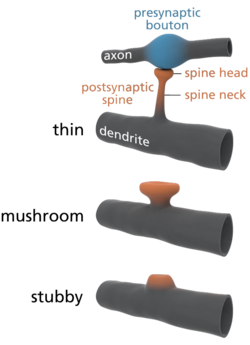| Dendritic spine | |
|---|---|
 Spiny dendrite of a striatal medium spiny neuron. | |
 Common types of dendritic spines. | |
| Details | |
| Identifiers | |
| Latin | gemmula dendritica |
| MeSH | D049229 |
| TH | H2.00.06.1.00036 |
| Anatomical terms of microanatomy | |
A dendritic spine (or spine) is a small membranous protrusion from a neuron's dendrite that typically receives input from a single axon at the synapse. Dendritic spines serve as a storage site for synaptic strength and help transmit electrical signals to the neuron's cell body. Most spines have a bulbous head (the spine head), and a thin neck that connects the head of the spine to the shaft of the dendrite. The dendrites of a single neuron can contain hundreds to thousands of spines. In addition to spines providing an anatomical substrate for memory storage and synaptic transmission, they may also serve to increase the number of possible contacts between neurons.[1] It has also been suggested that changes in the activity of neurons have a positive effect on spine morphology.[2]